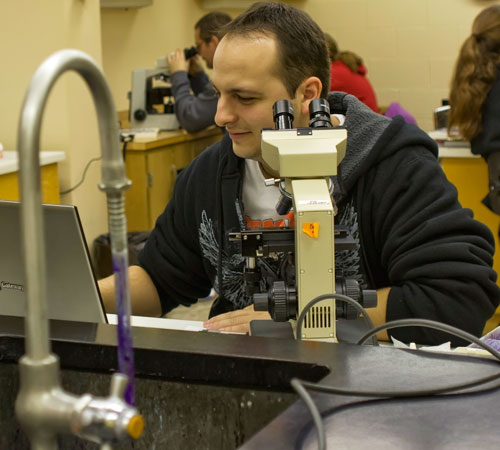More students attend medical schools

Elio Beta, a first-year medical student, works on a lab for his medical histology class in the Medical Science Building on Wednesday afternoon. More first-year students are attending medical school than ever before. Erica Magda
November 3, 2008
More first-year students are attending medical school this year than ever before.
According to a report by the Association of American Medical Colleges, almost 2 percent more first-year students are enrolled than the previous school year. This comes while there is a shortage of physicians across the country, said Joe Goldberg, assistant professor of clinical medicine. He said the shortage of physicians is due to doctors working shorter hours than they used to, an aging population that is living longer and advances in technology that allow for more procedures, which require more doctors.
“Because of the miracles of modern medicine more people are living longer,” Goldberg said. “We can do so much more for people.”
People who need medical attention are in danger, Goldberg said. When the current work force begins needing doctors for serious medical reasons, there may not be enough, he added.
“The picture doesn’t look very bright,” Goldberg said.
Get The Daily Illini in your inbox!
Linda Singleton, associate director of admissions for the University of Illinois’ Chicago medical school, said there are 308 students in the University of Illinois’ 2008-09 medical school class, eight more than recent class sizes. She said this is because more students accepted the school’s offer of admission than in past years.
The number of first-year Latino students increased by more than 10 percent this school year; the number of Native American students attending medical school for the first time increased by more than 5 percent; and the number of African-American students remained the same as in 2007.
There are more programs for Latinos now than in the past, although Raul Vasquez, information research specialist at the Hispanic Center of Excellence at the Chicago campus, said there still are not enough.
The University’s Urbana-Champaign and Chicago campuses have 51 Latino students in this year’s class, tying 2006 for the most students in a class.
Vasquez said the number of Latino students has increased steadily since the early 1990s.
“There’s a greater interest in medicine,” he added. “(There is a) desire to eliminate these health disparities.”
Mercer University College of Medicine, Texas A&M; Health Science Center College and the University of Arizona College of Medicine, among others, have opened or are opening new branches, which the report credits for helping increase the number of admitted medical students across the county.
“We’re trying to expand our program,” said Brittany Witt, admissions office employee for the Texas A&M; Health Science Center.
Goldberg said that while there are new medical schools, none has expanded to the extent needed to produce enough doctors. It is difficult and cyclical because to create more medical schools, universities need to take medical professionals out of hospitals to teach, Goldberg said.
“It’s not going to crack the nut,” he said. “We know what we need to do. There just needs to be a will to do it.”
Although more first-year students are going to medical school than ever before, Goldberg said there needs to be 20 percent more physicians in the workforce. Goldberg said the shortage of physicians will not be fixed soon because public schools are not receiving the money from the government to increase the size of medical schools, and private schools have lost part of their endowments due to the stock market crash.
The poor economy is also hurting students’ ability to afford medical school, Goldberg said. “This economic downturn is cutting down on families’ (ability) to pay tuition. We may be experiencing a dollar crunch from the students’ side.”
Goldberg said seats in medical schools and spots in residencies are often filled by foreign students. As the physicians shortage continues, hospitals will hire these students. Many foreign students want to stay in the United States because there is more technology than in their home countries, but the rest of the world is then left without help, Goldberg said.
“We’ve got a catastrophe, and it’s just waiting to happen,” Goldberg said.






